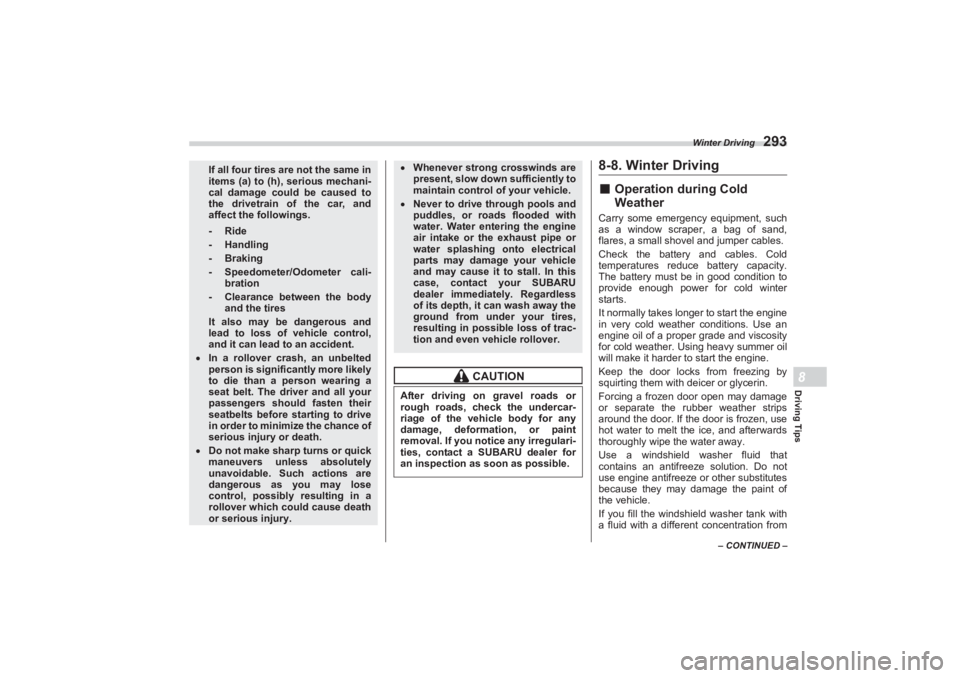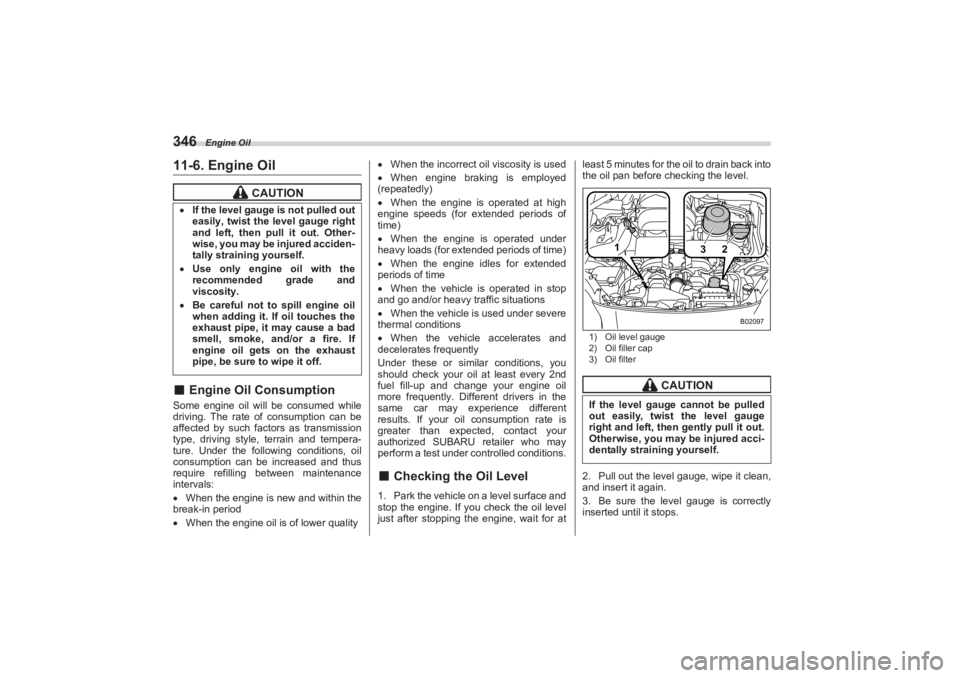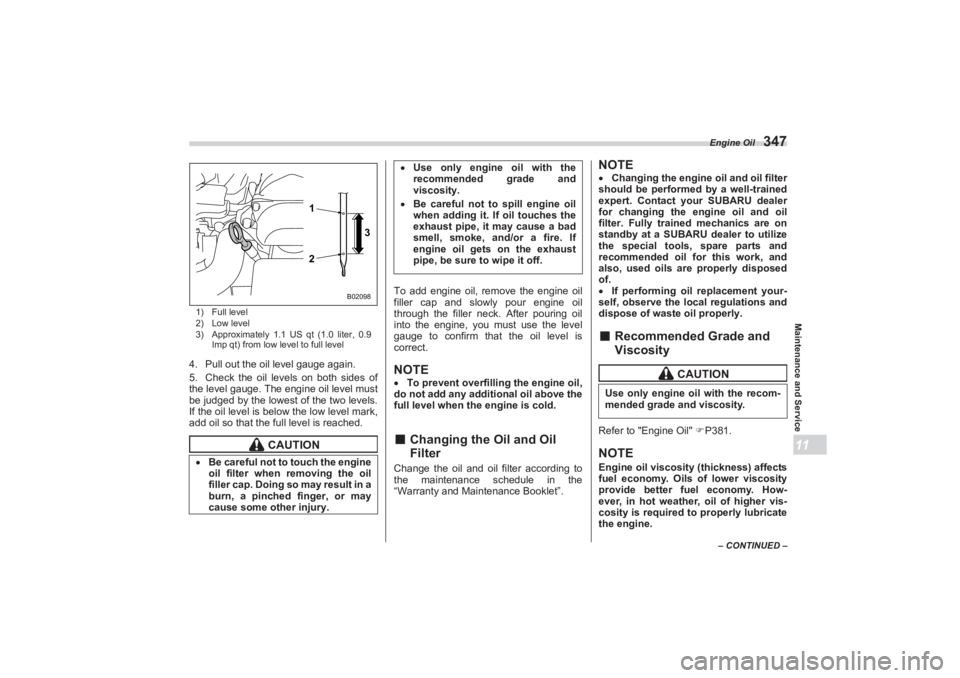2023 SUBARU BRZ oil viscosity
[x] Cancel search: oil viscosityPage 299 of 432

Winter Driving
293
Driving Tips8
– CONTINUED –
8-8. Winter Driving■Operation during Cold
WeatherCarry some emergency equipment, such
as a window scraper, a bag of sand,
flares, a small shovel and jumper cables.
Check the battery and cables. Cold
temperatures reduce battery capacity.
The battery must be in good condition to
provide enough power for cold winter
starts.
It normally takes longer to start the engine
in very cold weather conditions. Use an
engine oil of a proper grade and viscosity
for cold weather. Using heavy summer oil
will make it harder to start the engine.
Keep the door locks from freezing by
squirting them with deicer or glycerin.
Forcing a frozen door open may damage
or separate the rubber weather strips
around the door. If the door is frozen, use
hot water to melt the ice, and afterwards
thoroughly wipe the water away.
Use a windshield washer fluid that
contains an antifr eeze solution. Do not
use engine antifreeze or other substitutes
because they may damage the paint of
the vehicle.
If you fill the windshield washer tank with
a fluid with a different concentration from
If all four tires are not the same in
items (a) to (h), serious mechani-
cal damage could be caused to
the drivetrain of the car, and
affect the followings.-Ride-Handling- Braking- Speedometer/Odometer cali-
bration- Clearance between the body
and the tires
It also may be dangerous and
lead to loss of vehicle control,
and it can lead to an accident.
In a rollover crash, an unbelted
person is significantly more likely
to die than a person wearing a
seat belt. The driver and all your
passengers should fasten their
seatbelts before st arting to drive
in order to minimize the chance of
serious injury or death. Do not make sharp turns or quick
maneuvers unless absolutely
unavoidable. Such actions are
dangerous as you may lose
control, possibly resulting in a
rollover which could cause death
or serious injury.
Whenever strong crosswinds are
present, slow do wn sufficiently to
maintain control of your vehicle. Never to drive through pools and
puddles, or roads flooded with
water. Water entering the engine
air intake or the exhaust pipe or
water splashing onto electrical
parts may damage your vehicle
and may cause it to stall. In this
case, contact your SUBARU
dealer immediat ely. Regardless
of its depth, it can wash away the
ground from under your tires,
resulting in possible loss of trac-
tion and even vehicle rollover.
CAUTION
After driving on gravel roads or
rough roads, check the undercar-
riage of the vehicle body for any
damage, deformation, or paint
removal. If you notice any irregulari-
ties, contact a SUBARU dealer for
an inspection as soon as possible.
BRZ_U.book 293 ページ 2022年3月29日 火曜日 午後3時59分
Page 343 of 432

Maintenance and Service11
Maintenance and Service
11-1. Maintenance Schedule .....................................339
11-2. Maintenance Precautions.................................339
Before Checking or Servicing in the Engine
Compartment ..............................................................340
When Checking or Servicing in the Engine Compartment ..............................................................340
When Checking or Servicing in the Engine Compartment While the Engine Is Running ............341
11-3. Maintenance Tips ..............................................341
Removing and Reinstalling Clips................................341
11-4. Engine Hood ......................................................343
11-5. Engine Compartment Overview.......................345
11-6. Engine Oil ..........................................................346
Engine Oil Consumption..............................................346
Checking the Oil Level .................................................346
Changing the Oil and Oil Filter ....................................347
Recommended Grade and Viscosity ..........................347
Synthetic Oil..................................................................348
11-7. Cooling System .................................................348
Cooling Fan, Hose and Connections ..........................348
Engine Coolant .............................................................349
11-8. Air Cleaner Element ..........................................350
Replacing the Air Cleaner Element .............................350
11-9. Spark Plugs .......................................................352
Recommended Spark Plugs ........................................352
11-10. Drive Belt .........................................................352
11-11. Automatic Transmission Fluid ......................352
Recommended Grade and Viscosity ..........................352
11-12. Differential Gear Oil ........................................353
Recommended Grade and Viscosity ..........................353
11-13. Manual Transmission Oil ...............................353
Recommended Grade and Viscosity ..........................353
11-14. Brake Fluid ......................................................353
Checking the Fluid Level ............................................ 353
Recommended Brake Fluid ........................................ 354
11-15. Clutch Fluid (MT models) ...............................354
Checking the Fluid Level ............................................ 354
Recommended Clutch Fluid ....................................... 355
11-16. Brake Booster .................................................355
11-17. Brake Pedal .....................................................356
11-18. Clutch Pedal (MT models) ..............................356
11-19. Replacement of Brake Pad and Lining..........356
Breaking-in of New Brake Pads and Linings ............ 357
11-20. Parking Brake Stroke ......................................357
11-21. Tires and Wheels ............................................358
Types of Tires .............................................................. 358
Tire Pressure Monito ring System (TPMS)
(If Equipped)............................................................... 358
Tire Inspection ............................................................. 360
Tire Pressures and Wear............................................. 361
Wheel Balance ............................................................. 363
Wear Indicators ............................................................ 363
Rotational Direction of Tires....................................... 364
Tire Rotation................................................................. 364
Tire Replacement ...... ............................. ...................... 365
Wheel Replacement ..................................................... 365
11-22. Alloy Wheels ....................................................366
11-23. Windshield Washer Fluid ...............................366
11-24. Replacement of Wiper Blades........................367
Windshield Wiper Blade Assembly ............................ 368
Windshield Wiper Blade Rubber ................................ 369
11-25. Battery ..............................................................370
11-26. Fuses ................................................................371
11-27. Installation of Acce ssories ............................373
BRZ_U.book 337 ページ 2022年3月29日 火曜日 午後3時59分
Page 352 of 432

Engine Oil
34611-6. Engine Oil■Engine Oil ConsumptionSome engine oil will be consumed while
driving. The rate of consumption can be
affected by such factors as transmission
type, driving style, terrain and tempera-
ture. Under the followi ng conditions, oil
consumption can be increased and thus
require refilling between maintenance
intervals:
When the engine is new and within the
break-in period
When the engine oil is of lower quality
When the incorrect oil viscosity is used
When engine braking is employed
(repeatedly)
When the engine is operated at high
engine speeds (for extended periods of
time)
When the engine is operated under
heavy loads (for extended periods of time)
When the engine idles for extended
periods of time
When the vehicle is operated in stop
and go and/or heavy traffic situations
When the vehicle is used under severe
thermal conditions
When the vehicle accelerates and
decelerates frequently
Under these or similar conditions, you
should check your oil at least every 2nd
fuel fill-up and change your engine oil
more frequently. Different drivers in the
same car may experience different
results. If your oil consumption rate is
greater than expected, contact your
authorized SUBARU retailer who may
perform a test under controlled conditions.
■ Checking the Oil Level1. Park the vehicle on a level surface and
stop the engine. If you check the oil level
just after stopping the engine, wait for at least 5 minutes for the oil to drain back into
the oil pan before checking the level.
1) Oil level gauge
2) Oil filler cap
3) Oil filter2. Pull out the level gauge, wipe it clean,
and insert it again.
3. Be sure the level gauge is correctly
inserted until it stops.
CAUTION
If the level gauge is not pulled out
easily, twist the level gauge right
and left, then pull it out. Other-
wise, you may be injured acciden-
tally straining yourself. Use only engine oil with the
recommended grade and
viscosity. Be careful not to spill engine oil
when adding it. If oil touches the
exhaust pipe, it may cause a bad
smell, smoke, and/or a fire. If
engine oil gets on the exhaust
pipe, be sure to wipe it off.
CAUTION
If the level gauge cannot be pulled
out easily, twist the level gauge
right and left, then gently pull it out.
Otherwise, you may be injured acci-
dentally straining yourself.
1
3
2
B02097
BRZ_U.book 346 ページ 2022年3月29日 火曜日 午後3時59分
Page 353 of 432

Engine Oil
347
Maintenance and Service11
– CONTINUED –
1) Full level
2) Low level
3) Approximately 1.1 US qt (1.0 liter, 0.9
Imp qt) from low level to full level
4. Pull out the oil level gauge again.
5. Check the oil levels on both sides of
the level gauge. The engine oil level must
be judged by the lowest of the two levels.
If the oil level is below the low level mark,
add oil so that the full level is reached. To add engine oil, remove the engine oil
filler cap and slowly pour engine oil
through the filler neck. After pouring oil
into the engine, you must use the level
gauge to confirm that the oil level is
correct.
NOTE To prevent overfilling the engine oil,
do not add any additional oil above the
full level when the engine is cold.
■ Changing the Oil and Oil
FilterChange the oil and oil filter according to
the maintenance schedule in the
“Warranty and Maintenance Booklet”.
NOTE Changing the engine oil and oil filter
should be performed by a well-trained
expert. Contact your SUBARU dealer
for changing the engine oil and oil
filter. Fully trained mechanics are on
standby at a SUBARU dealer to utilize
the special tools, spare parts and
recommended oil for this work, and
also, used oils are properly disposed
of.
If performing oil replacement your-
self, observe the local regulations and
dispose of waste oil properly.■ Recommended Grade and
ViscosityRefer to "Engine Oil" P381.NOTEEngine oil viscosity (thickness) affects
fuel economy. Oils of lower viscosity
provide better fuel economy. How-
ever, in hot weather, oil of higher vis-
cosity is required to properly lubricate
the engine.
CAUTION
Be careful not to touch the engine
oil filter when removing the oil
filler cap. Doing so may result in a
burn, a pinched finger, or may
cause some other injury.
1
2 3
B02098
Use only engine oil with the
recommended grade and
viscosity. Be careful not to spill engine oil
when adding it. If oil touches the
exhaust pipe, it may cause a bad
smell, smoke, and/or a fire. If
engine oil gets on the exhaust
pipe, be sure to wipe it off.
CAUTION
Use only engine oil with the recom-
mended grade and viscosity.
BRZ_U.book 347 ページ 2022年3月29日 火曜日 午後3時59分
Page 354 of 432

Cooling System
348■Synthetic OilYou should use synthetic engine oil that
meets the same requirements given for
conventional engine oil. When using
synthetic oil, you must use oil of the same
classification, viscosity and grade shown
in this Owner’s Manual. Refer to "Engine
Oil" P381. Also, you must follow the oil
and filter changing intervals shown in the
Warranty and Maintenance booklet.NOTESynthetic oil of the grade and viscosity
noted in chapter 12 is the recom-
mended engine oil for optimum engine
performance. Conventional oil may be
used if synthetic oil is unavailable.
11-7. Cooling System
■ Cooling Fan, Hose and
ConnectionsYour vehicle employs an electric cooling
fan which is thermost atically controlled to
operate when the engine coolant reaches
a specific temperature.
If the radiator cooling fan does not operate
even when the engine coolant tempera-
ture gauge exceeds the normal operating
range, the cooling fan circuit may be
defective. Refer to "Engine Coolant
Temperature Gauge" P129.
WARNING
Never remove the radiator cap until
the engine has been shut off and
has cooled down completely. Since
the coolant is under pressure, you
may suffer serious burns from a
spray of boiling hot coolant when
the cap is removed.
CAUTION
Vehicles are filled at the factory
with SUBARU SUPER COOLANT
that does not require the first
change for 11 years/137,500 miles
(11 years/220,000 km). This
coolant should not be mixed with
any other brand or type of coolant
during this period. Mixing with a
different coolant will reduce the
life of the coolant. When neces-
sary to top off the coolant for any
reason, use only SUBARU
SUPER COOLANT.
If the SUBARU SUPER COOLANT
is diluted with another brand or
type, the maintenance interval is
shortened to that of the mixing
coolant.
Do not splash the engine coolant
over painted parts. The alcohol
contained in the engine coolant
may damage the paint surface.
B02099
BRZ_U.book 348 ページ 2022年3月29日 火曜日 午後3時59分
Page 358 of 432

Spark Plugs
35211-9. Spark PlugsIt may be difficult to replace the spark
plugs. It is recommended that you have
the spark plugs replaced by your
SUBARU dealer.
The spark plugs should be replaced
according to the maintenance schedule in
the “Warranty and Maintenance Booklet”.■ Recommended Spark PlugsRefer to "Electrical System" P385.
11-10. Drive BeltIt is unnecessary to check the deflection of
the drive belt periodically because your
engine is equipped with an automatic belt
tension adjuster. However, replacement
of the belt should be done according to the
maintenance schedule in the “Warranty
and Maintenance Booklet”. Consult your
SUBARU dealer for replacement.
If the belt is loose, cracked or worn, we
recommend that contact your SUBARU
dealer.
11-11. Automatic Transmis -sion FluidIt is not necessary to check the transmis-
sion oil level. Check that there are no
cracks, damage or leakage. However,
have the oil inspected by your SUBARU
dealer according to the maintenance
schedule in the “Warranty and Mainte-
nance Booklet”. Consult your SUBARU
dealer for details.■ Recommended Grade and
ViscosityEach oil manufacturer has its own base
oils and additives. Never use different
brands together. For details, refer to
"Fluids" P383.
BRZ_U.book 352 ページ 2022年3月29日 火曜日 午後3時59分
Page 359 of 432

Differential Gear Oil
353
Maintenance and Service11
– CONTINUED –
11-12. Differential Gear OilIt is not necessary to check the gear oil
level. Check that there are no cracks,
damage or leakage. However, the oil
inspection should be performed according
to the maintenance schedule in the
“Warranty and Maintenance Booklet”.
Consult your SUBARU dealer for details.■ Recommended Grade and
ViscosityEach oil manufacturer has its own base
oils and additives. Never use different
brands together. For details, refer to
"Manual Transmission and Differential
Gear Oil" P383.
11-13. Manual Transmission OilIt is not necessary to check the transmis-
sion oil level. Check that there are no
cracks, damage or leakage. However,
have the oil inspected by your SUBARU
dealer according to the maintenance
schedule in the “Warranty and Mainte-
nance Booklet”. Consult your SUBARU
dealer for details.■ Recommended Grade and
ViscosityEach oil manufacturer has its own base
oils and additives. Never use different
brands together. For details, refer to
"Manual Transmission and Differential
Gear Oil" P383.
11-14. Brake Fluid■ Checking the Fluid Level
CAUTION
Using a differential gear oil other
than the specified oil may cause a
decline in vehicle performance.
WARNING
Never let brake fluid contact your
eyes because brake fluid can be
harmful to your eyes. If brake
fluid gets in your eyes, immedi-
ately flush them thoroughly with
clean water. Fo r safety, when
performing this work, wearing
eye protection is advisable. Brake fluid absorbs moisture
from the air. Any absorbed mois-
ture can cause a dangerous loss
of braking performance. If the vehicle requires frequent
refilling, there may be a leak. If
you suspect a problem, have the
vehicle checked at your SUBARU
dealer.
CAUTION
When adding brake fluid, be
careful not to allow any dirt into
the reservoir. Never splash the brake fluid over
painted surfaces or rubber parts.
Alcohol contained in the brake
fluid may damage them.
BRZ_U.book 353 ページ 2022年3月29日 火曜日 午後3時59分
Page 387 of 432

Specifications
381
Specifications12
– CONTINUED –
■Fuel*1: For details, refer to "Fuel" P223.■ Engine OilFor the checking, adding and replacing procedure or other details, refer to "Engine Oil" P346.NOTEThe procedure for changing the engine oil and oil filter should be performed by a properly-trained expert. It is recom-
mended that you have this service performed by your SUBARU dealer.
▼ Approved engine oil
Always use the SUBARU approved engine oil. For fu rther details, please contact your SUBARU dealer.
If the approved engine oil is unavailable, use the alternative engine oil described on the next page.
▼ Alternative engine oil
If the SUBARU approved oil is unavailable, the following alternative oil can be used.NOTE Each quantity indicated is only a guideline. The necessary quantity for replacement may differ slightly depending on the
temperature and other factors.
In choosing an oil, you want the proper quality and viscosity, as well as one that will enhance fuel economy. Oils of lower
viscosity provide better fuel economy. However, in hot weather, oil of higher viscosity is required to properly lubricate the
engine. The following table lists the recommend ed viscosities and applicable temperatures.Compression ratio 12.5 : 1
Firing order 1 – 3 – 2 – 4
Fuel requirement
*1
Unleaded gasoline with 93 AKI (98 RON) or higher
Fuel tank capacity 13.2 US gal (50 liters, 11.0 Imp gal)
Engine model
FA24 (2.4 L, DOHC, non-turbo)
BRZ_U.book 381 ページ 2022年3月29日 火曜日 午後3時59分